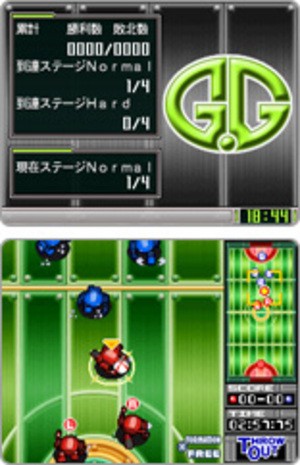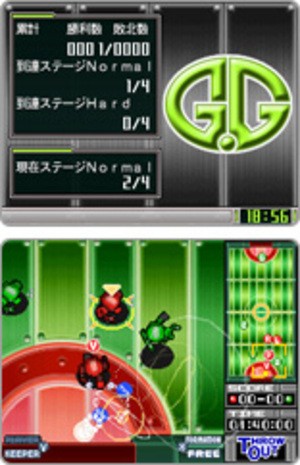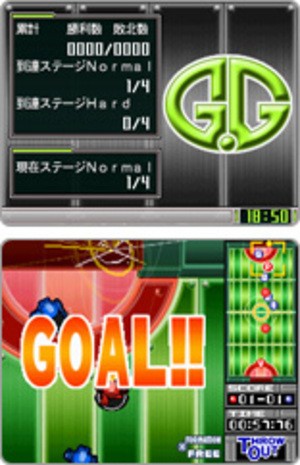
Although "proper" sports video games have been more successful at home and in the arcades, there's something to be said for the made up ones that have less focus on player stats and more on just playing the game. Suzak's Throw Out, a more recent entry in the G.G. Series of budget arcade-style games, is definitely one of the latter: a game that marries American football and the sport known in North America as "soccer," strongly echoing Atari Games' 1990s classic Cyberball.
As with Cyberball, you control a team of robots trying to cross a field and get a ball into a goal, but whilst Cyberball had more of the trappings of American football with downs, field goals and touchdowns, Throw Out is clearly modelled on soccer. In fact, the main difference is that your robots carry the ball in their hands rather than dribbling it with their feet and throw it into the goal instead of kicking it.
You get a choice of four teams with different names, colours and strengths, with one being balanced, one faster, one harder to knock down and so on. There's a choice of normal and hard difficulty and then whether to play a single game or a full four-round tournament ending with a championship against a fifth team.

The game itself isn't too long, consisting of two halves of three minutes each with a side change at halftime. Like all G.G. Series games, Throw Out only uses the bottom screen for gameplay, a bit of a shame here since the playfield is vertical and would have benefited from using the top screen to show more of it. In order to compensate for the close-in camera and limited screen real estate you'll have a marker pointing in the direction of the ball if it's not currently on screen, and a radar over to the right indicating your players and the other team. You can freely switch control between all four of your players, though with the exception of goalkeeping the AI does a good job on its own.
There are three fielders and one goalie on each side, with limited control over their formation via the X button. You'll always start out controlling the middle player with the ability to switch to the other two being mapped to the L and R shoulder buttons, whilst switching to goal is via the Y button. You'll automatically switch control to the player with the ball when you gain possession of it, changing the button assignment for the other players when a different player gains possession. This can be a bit disorienting as the camera moves around quickly, and in the middle of battling for the ball it's easy to get lost if you're trying to switch players to be the one closest to the ball only to have that one gain possession at the same time as the button assignment switches to another player. The fact that the Y button does double-duty as the control for throwing the ball can also result in some accidental switching to your goalie if you mistakenly think you have the ball and try to make a shot at the opponent's goal line. Once you have the ball you can pass it to the other players simply by pressing the button to switch to them, which is intuitive and works well.

Play basically consists of getting the ball, running to your opponent's goal and then trying to throw it in. Opposition goalies are quite good, so you'll want to try jumping throws by pressing B (also used to intercept your opponent's throws when controlling your own goalkeeper) and then charging your throw by holding Y before releasing it. The best strategy seems to be to try to stun the goalie with a strong hit and then regain the ball to throw it in again. You can get quite close to goal, but if you cross the outer line it's a foul and the goalkeeper gets the ball, although you can jump over the foul line (and past the goalie) to make a shot if you get lucky.
Taking the ball away from the opposition is as easy as running up to them and pressing A to hit them – just remember that they can take the ball off you the same way, leading to some frantic back-and-forth ball stealing and jumping to stay out of reach of an enemy charge. Once you get clear of the scrum it's unlikely you'll be caught, though getting an easy goal is extremely rare, making double-digit scores unlikely. Even so we were able to win the tournament at Normal difficulty in our first attempt. Hard difficulty offers a bit more of a challenge, but really this game would be even better with a local multiplayer option; unfortunately as with the rest of the G.G. Series, this is strictly a single-player game.
Throw Out is a satisfying experience following in the footsteps of a fun arcade game. Robots and sport certainly seem to go well together, though you'll probably always have more fun with a human opponent at the controls.
Comments 3
This seems pretty cool actually.
Unlike most of the G.G. series this is one I'll want to give a miss because I have no interest in either of the sports in this combination.
I downloaded it before reading this impressions. I liked it, but I think it's very easy, even in the hard difficulty. There is only 1 team that gives me trouble in hard difficulty, the secret one (no selectable).
By the way, there is a way to score a goal directly. If you hold the shoot button while you are jumping, and you release it in the appropiate time (not for long time but also not for short time), you will do a great shoot that has a great chance to pass the goalkeeper.
Show Comments
Leave A Comment
Hold on there, you need to login to post a comment...